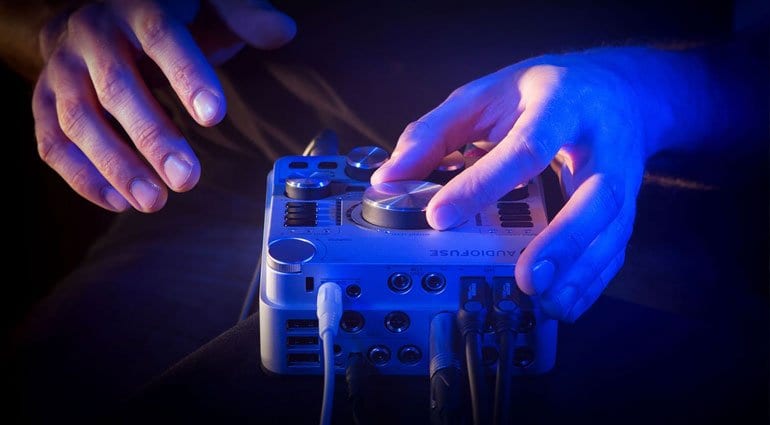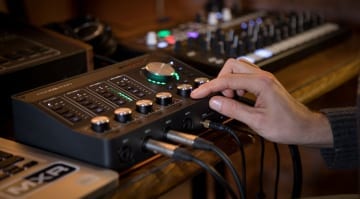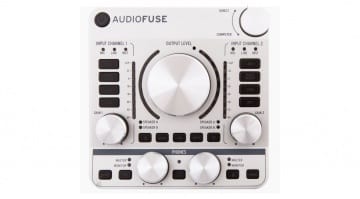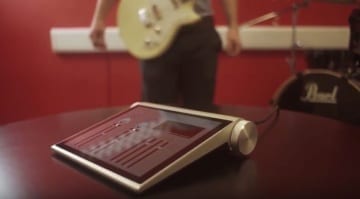AudioFuse: The futuristic audio interface that’s 2 years too late
It was NAMM 2015 when Arturia announced and demonstrated their “next-generation” audio interface. Their tagline of “You’re making tomorrow’s music… so why settle for yesterday’s interface?” has become so painfully ironic that when I heard that the AudioFuse is finally about to be released I burst out laughing.
AudioFuse
As soon as I saw it I thought it was one cool bit of gear. Stuffed full of features, dripping with connections and designed into an uber-quirky box. 2 audio inputs, 2 phono inputs, S/PDIF and ADAT, outputs to match, inserts and a USB hub. This was Arturia at their best. Then it simply refused to appear. The website held all the specs and all the details. Every promotional video for other Arturia products seemed to have an AudioFuse in there being the audio interface for something. Shops listed them as “coming soon”. But there was no sign of the hardware. 2 years past and there was no news, no update, no change to the stoic status of being something for the future. Until now.
June 8th 2017 is officially the release date of the Arturia AudioFuse. They’ve put together a great, quirky teaser video and are acting as if nothing has happened.
So what did happen? Why was it announced at NAMM in 2015? Why was it launched at AES later that year only not to appear? What has taken two and a half years to perfect?
Arturia have been active on Facebook since this new announcement fending off the obvious questions. The closest we’ll get to a statement is this reply to a commenter on a Facebook post by Synthtopia:
we could have released the product earlier but wanted to make sure we release a product that is as good as we can possibly make it, instead of releasing something that isn’t perfect. We’re there now, and looking forward to (finally!) getting it out there in the real world.
I still think it looks like a great box. The controls are perhaps a little squished in there but 2 years ago it had everything you could possibly want from an audio interface. But that’s the thing, 2 years can be a long time. It has a USB hub, which is great, but it’s not USB 3.1 or even USB 3 let alone Thunderbolt which is where the low latency is found these days. The inclusion of a phono input actually seems dated now. The recent rise of modular and CV control, even in Arturia’s own products, would make a pair of DC coupled CV inputs and outputs much more future looking. In many ways the AudioFuse may have missed its window and we should be expecting the MK2 version by now.
Is it still interesting enough to compete? At around the £500 price mark you’ve got Focusrite Clarett 2Pre and 4Pre Thunderbolt interfaces, or their 18i20 Scarlett USB interface. There’s the UAD Apollo Twin Solo in Thunderbolt, the PreSonus Studio 192, or the Keith McMillen K-Mix. So it has a lot to live up to. For me the controls are excellent and so are the ADAT ports simply because with an Expert Sleepers ADAT-to-CV module I could use them to interface with my modular. I like the different colour schemes but otherwise, I feel perhaps the connections are a bit behind the times.
However, who knows what it’s like in use and what developments there might have been in these extra 2 years of fiddling. Could it actually be more awesome than we thought? Once it’s out and all the details are official I’ll round it all up and give you my thoughts.
The current, unchanged specs are available on the Arturia website.
Update: It’s now released with no discernable differences to the original specs. But they do have a nice new video:
You are currently viewing a placeholder content from YouTube. To access the actual content, click the button below. Please note that doing so will share data with third-party providers.
Original teaser video:
You are currently viewing a placeholder content from YouTube. To access the actual content, click the button below. Please note that doing so will share data with third-party providers.
7 responses to “AudioFuse: The futuristic audio interface that’s 2 years too late”









One with usb audio out and usb midi out to computer, multiple midiports, at least two cv/gates, three clock outputs with dividers, two or three usb inputs, ios comptibility plus few normal inputs. Thank you.
Im about to test one tomorrow (I work with a music retailer)
I find the whole “it appears a bit dated ” statement pretty funny.
As someone who recently owned a Kmix, and is returning it due to a major
issue (noise floor issues on certain pencil condenser mics) the idea of
it being two years late only bothers me a little.
If it sounds good..it is good.
Adat expandability, phono preamps (if they are good..sucked on the Kmix)
The usb hub..IF it works well, it will suit me just fine.
After being a beta tester with a kmix, better late and ready I say.
Cool. I have a K-Mix and it’s not quite everything i hoped it would be. Are you running the AudioFuse on Windows or Mac? I’d really like to know how well those generic drivers work.
Running on a mac..there are no drivers on the mac side for either the Kmix or the audiofuse..the software is just a control panel on the mac side
SOS mag says it runs with a third party ASIO driver on Windows and is a bit lack-lustre – which is a shame.
Lack lustre..lol…how so?
Well, not great low latency performance – so probably ok at 256 or 128 samples but lots of CPU pressure under that. RME and MOTU always write exceptional drivers that give amazing performance at low latency. Arturia decided not to try to do that – they bought in a driver from somewhere else which is never going to give the performance of a proper proprietary one. Performance of audio drivers varies enormously – you can change audio interfaces and find that your CPU meter drops and you can run dozens more plug-ins at the same latency. Arturia’s claims about super low latency are inaccurate – at least, it seems, on Windows – as are their claims about using only generic drivers (which is a weird thing to have as a feature). No wonder it took them 2 years to finish – they couldn’t get a driver to work properly… probably. It’s a shame as it’s a great feature set otherwise.
You are currently viewing a placeholder content from Facebook. To access the actual content, click the button below. Please note that doing so will share data with third-party providers.
More InformationYou are currently viewing a placeholder content from Instagram. To access the actual content, click the button below. Please note that doing so will share data with third-party providers.
More InformationYou are currently viewing a placeholder content from X. To access the actual content, click the button below. Please note that doing so will share data with third-party providers.
More Information